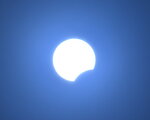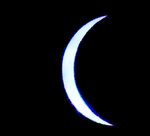



And just like that it’s over.
The awe-inspiring total eclipse of the sun that drew millions across the U.S., Mexico and Canada with hopes of seeing the rare cosmic event is now history.
Despite the cloud cover that interrupted the show for many, Monday’s eclipse will live on in the memories of those who saw several minutes of midday darkness and temperatures drop as the moon passed fully between Earth and the glowing sun. The best views came in Mexico and, toward the end of the eclipse, in Vermont and Maine. New Brunswick and Newfoundland also had some spectacular scenes, according to the National Weather Service.
While some traveled hundreds and even thousands of miles with the dream of seeing the spectacle, Doylestown residents were lucky to have mostly clear skies throughout the afternoon.
“I may not be alive in 20 years, “said Barbara Reich, who brought her Havanese “Jackpot” and her friend Jeanne Wilson to watch the eclipse from the deck of Villa Capri Pizzeria in the borough.
Wilson was quite clear on her reason for coming. “I have an inquiring mind,” she said. “I always have.”
As the restaurant’s owner, Matt Mannino, pumped Pink Floyd’s “Dark Side of the Moon,” through the speakers, families and friends pulled out their protective eyewear and gazed upward. The atmosphere was festive, but as the eclipse became noticeable, the small crowd grew quiet. Children watched, mesmerized.
When clouds moved in and the parting of the eclipse could not really be seen, the sky darkened and people reached for their jackets and sweaters. Mannino briefly turned on the outdoor heaters.
For some the event was a once-in-a-lifetime experience. But not for Michelangelo Di Sandro.
“I was 10 years old in 1958 in Molise, Italy when there was a total eclipse,” he said from his table on Villa’s deck. “It was pitch black. It was incredible,” he remembered. “School was let out, but our teachers told us to get a piece of glass and smoke it over a fire so we could watch it.”
Monday’s eclipse was not the first for Michael Di Palma either. He recalled with a smile seeing a total eclipse in 1978. “I lived in Goldendale, Washington, where the observatory is in the Cascade Mountains. It was beautiful.”
The next total eclipse that will be visible from the United States won’t be until 2044.
Join our readers whose generous donations are making it possible for you to read our news coverage. Help keep local journalism alive and our community strong. Donate today.